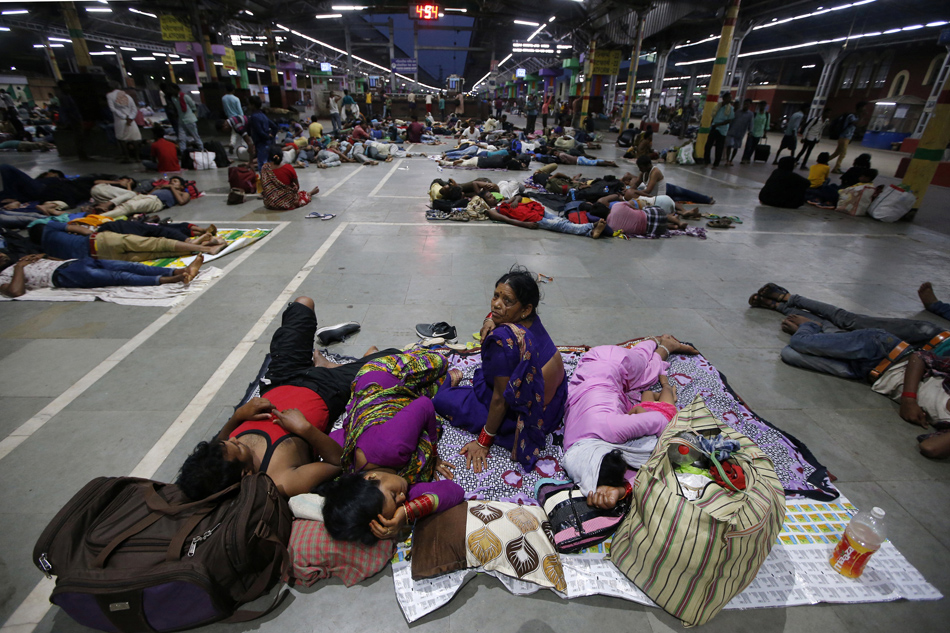Monster cyclone reaches India's east coast | ABS-CBN
ADVERTISEMENT

Welcome, Kapamilya! We use cookies to improve your browsing experience. Continuing to use this site means you agree to our use of cookies. Tell me more!
Monster cyclone reaches India's east coast
Monster cyclone reaches India's east coast
Hari Kumar and Austin Ramzy,
The New York Times
Published May 03, 2019 01:29 PM PHT
BHUBANESWAR, India — Hundreds of thousands of people evacuated parts of India’s eastern coast Thursday as an “extremely severe” cyclone moved north through the Bay of Bengal, bringing fears of widespread destruction from heavy rain, powerful winds and storm surges in low-lying areas.
BHUBANESWAR, India — Hundreds of thousands of people evacuated parts of India’s eastern coast Thursday as an “extremely severe” cyclone moved north through the Bay of Bengal, bringing fears of widespread destruction from heavy rain, powerful winds and storm surges in low-lying areas.
Cyclone Fani, classified by meteorologists as the equivalent of a Category 4 hurricane, made landfall along the coast at 8 a.m. Friday after churning through the bay, which has produced many of the world’s deadliest tropical cyclones.
Cyclone Fani, classified by meteorologists as the equivalent of a Category 4 hurricane, made landfall along the coast at 8 a.m. Friday after churning through the bay, which has produced many of the world’s deadliest tropical cyclones.
By late Thursday in India, Fani had sustained winds of about 155 mph, nearly in the range of a Category 5 hurricane, said Derrick Herndon, an associate researcher at the University of Wisconsin-Madison’s Cooperative Institute for Meteorological Satellite Studies. The World Meteorological Organization said the storm was “one of the most intense” in 20 years in the region.
By late Thursday in India, Fani had sustained winds of about 155 mph, nearly in the range of a Category 5 hurricane, said Derrick Herndon, an associate researcher at the University of Wisconsin-Madison’s Cooperative Institute for Meteorological Satellite Studies. The World Meteorological Organization said the storm was “one of the most intense” in 20 years in the region.
Tens of millions of people were potentially in the storm’s path.
Tens of millions of people were potentially in the storm’s path.
ADVERTISEMENT
In the beach village of Chandrabhaga, police helped residents move from thatched-roof homes to a nearby shelter Thursday afternoon. Evacuees sat on the floor of the shelter or in plastic chairs awaiting the storm’s arrival. By evening, the sea had turned rough and strong winds were lashing buildings along the coast.
In the beach village of Chandrabhaga, police helped residents move from thatched-roof homes to a nearby shelter Thursday afternoon. Evacuees sat on the floor of the shelter or in plastic chairs awaiting the storm’s arrival. By evening, the sea had turned rough and strong winds were lashing buildings along the coast.
The India Meteorological Department warned of the “total destruction” of thatched huts in some districts, major damage to roads, the uprooting of power poles and danger from flying objects.
The India Meteorological Department warned of the “total destruction” of thatched huts in some districts, major damage to roads, the uprooting of power poles and danger from flying objects.
Officials said the storm could be the most powerful to strike India since 1999, when a cyclone killed more than 10,000 people in the same region of eastern India. But authorities have significantly improved disaster preparation and response capabilities in the years since, and subsequent major storms have resulted in far fewer deaths.
Officials said the storm could be the most powerful to strike India since 1999, when a cyclone killed more than 10,000 people in the same region of eastern India. But authorities have significantly improved disaster preparation and response capabilities in the years since, and subsequent major storms have resulted in far fewer deaths.
Fani was forecast to drop as much as 8 inches of rain on northern parts of the state of Andhra Pradesh and on the state of Odisha. The storm was expected to continue north, hitting the neighboring countries of Bangladesh and Bhutan, as well as parts of the Indian states of West Bengal, Arunachal Pradesh, Assam and Meghalaya.
Fani was forecast to drop as much as 8 inches of rain on northern parts of the state of Andhra Pradesh and on the state of Odisha. The storm was expected to continue north, hitting the neighboring countries of Bangladesh and Bhutan, as well as parts of the Indian states of West Bengal, Arunachal Pradesh, Assam and Meghalaya.
More than 850 shelters were opened along Odisha’s coast, said Bishnupada Sethi, the state’s special relief commissioner. Each could hold about 1,000 people, along with livestock.
More than 850 shelters were opened along Odisha’s coast, said Bishnupada Sethi, the state’s special relief commissioner. Each could hold about 1,000 people, along with livestock.
2019 New York Times News Service
2019 New York Times News Service
ADVERTISEMENT
ADVERTISEMENT


